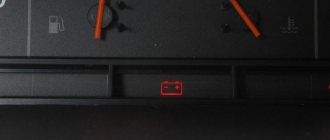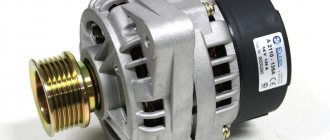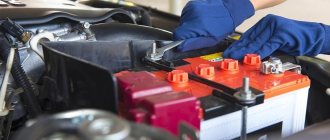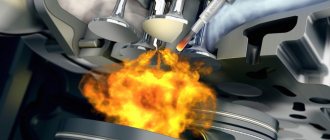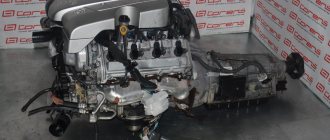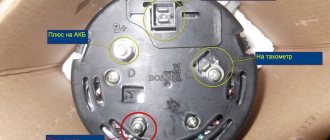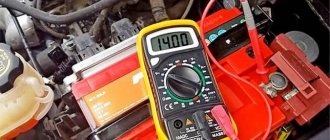Almost every motorist knows that it is impossible to drive with an undercharged battery; this can lead to an immediate need to replace the power source.
But most often, it is the battery itself that is blamed for undercharging, which supposedly has used up its resource, has undergone sulfation, and therefore can no longer work as before.
But this is a misconception. In fact, the fault may also lie with the car's alternator. There are several possible reasons why it may not charge the battery.
Why does the battery run out: did the patient sweat before dying?
Why does another battery give out after working for only a year or two? In a car, it is charged from a generator - at a constant voltage in the on-board network. After starting the engine, intensive charging lasts only a few minutes (this is called accelerated charging). The current at the beginning of the charge can reach tens of amperes, but then throughout the entire trip it is close to zero. With this “lifestyle”, the battery is constantly undercharged, large insoluble lead sulfate crystals form on the plates - they increase the internal resistance of the battery, and its capacity becomes less and less with each cycle.
Let us remind you that a battery whose terminal voltage has dropped to 10.2 V is considered completely discharged, since at less it will begin to deteriorate. But such a battery can easily start a working engine in the summer! It’s a different matter after a night in the cold; nothing will come of it for sure.
Often the batteries that are the leaders in advertising tests only work at C levels and don’t last long. This is partly due to the way they are charged before testing: using direct current allows you to achieve 100% compliance with the declared capacity. In this case, the voltage at the end of the charge can exceed 16 V. You will not find this in a working car. For example, on our “ten” there were both 13.2 and 14.7 V. The first may well kill any test winner! For the newest batteries, as a rule, a charging voltage of at least 15.1 V is required (as, for example, on Kalina). But some (the simpler and heavier ones) sometimes serve their owners for many years; seven or eight years is not so uncommon! Domestic ones, by the way, are made in such a way that they charge perfectly at a voltage of 14.5 V.
Reason #1. The battery drains a lot when parked
Diagnosed as follows. Immediately after parking the car after a day's use, the density of the electrolyte is measured. Let's say it's normal and shows that the battery is 100% charged. However, the next day, similar measurements show a decrease in density. Checking the battery voltage at rest also indicates that the battery is fairly discharged.
In such cases, if the battery is good (for example, it is new), in most cases large leakage currents are to blame. To measure them, you need to switch the multimeter to ammeter mode with a measurement range of up to 10 A, and connect it to the disconnected battery terminal. That is, make sure that currents flow from one of the battery terminals to the corresponding power wire (which you disconnected).
The normal current is considered to be within 0.07 A. It may vary noticeably on different cars. But, if you show more than the specified value, this is bad. We need to look for what is consuming so much and eliminate the cause. The easiest way to do this is by removing the fuses one by one and observing the response of the ammeter.
It is strictly prohibited to start the engine while measuring leakage currents! Conventional devices are not designed for starter inrush currents, which are more than 100 A.
Now let’s assume a situation where the leakage currents are normal, but a theoretically serviceable battery (almost new or new) is still discharged in the morning. In this case, you need to check the battery itself for current leakage. To do this, you need to disconnect it from the on-board network and measure the voltage between the positive terminal and different areas on its body. There should be zeros on the device. If there is voltage between the terminal and the case, then most likely the battery is just dirty and needs to be washed thoroughly.
Dust and dirt mixed with electrolyte vapors and settled on the body are an excellent conductor of current. It shouldn't exist.
On a starvation diet
Until recently, charging was controlled with an ammeter, but what's the point? The needle deviated only after starting the engine, and then firmly fell to zero! Later, this uninformative device was replaced by a voltmeter with colored sectors of the scale: an arrow in the green zone is normal, in the yellow zone the charge is weak, and in the red zone no, no! Later, the voltmeter was also abolished, replaced by a light bulb with a battery symbol. When you turn on the ignition it lights up, after starting the engine it goes out... and that's it. It is of little use as a control device. There may be no charging (for example, the alternator belt is loose or the contact on the wire from the alternator to the battery is lost), and the light will not light up and not warn! The standard on-board computer will also come to its senses no sooner than the voltage drops below normal.
Symptoms of malfunctions
The fact that the car's generator does not charge the battery can be determined by some characteristic signs.
If we are talking about modern cars, then problems and malfunctions of the electrical system are quite common and common occurrences.
There are several ways to tell if your alternator is not actually charging your car battery. The most common symptoms are:
- the battery light on the dashboard comes on;
- instability of the battery;
- boiling off of the electrolyte;
- constant undercharging, even after long trips;
- change in headlight intensity;
- extraneous sounds from the generator.
If the car starts to work incorrectly, there is a high probability that the battery is not receiving enough charge from the generator.
Smoking is harmful, everyone knows that. Even “lighting up” is not great. How to avoid getting infected with a bad habit?
Battery charging lost: reasons
Causes and solutions to the problem
All elements of the generator
If you have the opportunity to borrow someone else’s battery for testing, then you can try installing it in the car instead of yours. Of course, this battery must be fully working. Actually, in this way you can find out what the cause of the problem is - in the battery or in the generator. Below we will consider the reasons for this malfunction.
Internal condition of the battery
Typically, the reason why the generator cannot charge the battery is due to sulfation of the battery plates. In this case, the surface of the plates may be covered with salts - partially or completely - which prevent the battery from charging. If the degree of plate coverage is small, then, in principle, you can always try to restore the functionality of the battery. However, if the destruction process is no longer reversible, it will be necessary to replace the device.
As for restoring the battery structure from sulfation, this process can take more than one day, and the result and quality of restoration cannot be guaranteed. This means that you may eventually need a new battery anyway. The resuscitation procedure, as a rule, begins when the battery shows no signs of swelling, mechanical damage, cracks, etc. That is, the device body must be intact.
Installing battery terminals to terminals
But it should be borne in mind that the external state is not always a guarantee that the result will suit you. Inside the structure there are banks in which plates can break off, which ultimately leads to a short circuit. If this is the case, then there are no other options other than buying a new battery.
Terminals
Sometimes the indicator light may appear while driving a car. At this moment, you should not panic, as the reason may be quite banal. If you hit a bump or a hole, the contact may simply fall off the battery, especially if the terminal was not screwed on properly. If this is the case, then you just need to put it back in place and tighten it harder.
Problems with terminals can occur if they become oxidized at the point where they connect to the terminal. To solve this problem, the oxidation simply needs to be cleaned up. To do this you will need fine grit sandpaper. You need to be as careful as possible during the process, since you can accidentally cut off the lead part of the terminal, and this is unacceptable. If you erase more layers than necessary, the terminal will not hold well and will begin to fall off on every bump (video author - Avramenko Garage).
Generator belt
What charge should the generator provide and for what reasons does the battery overcharge or fail to charge? Quite often, the problem lies in the strap of the unit - if the tension is weak, the belt will begin to slip on the shaft, at this moment the unit will not be able to supply voltage to the system. The battery is switched and the charged battery turns from an energy consumer into a source of consumption, which is gradually discharged.
Diagnostics of the degree of belt tension can be carried out with the engine turned off. If the internal combustion engine is disconnected, you can try to tighten it if necessary. But it should be borne in mind that slippage can be caused not only by poor tension, but also by profile wear. This problem can only be solved by replacing the strap.
A wet or damp shaft can cause the impossibility of transmitting rotation - the strap will slide over the surface without effort. In order for the battery to charge normally, the pulley must be dry, so it will only be enough to dry it. It is quite difficult to determine slippage; in this case, the strap may break.
The cause of the problem may be oxidation of the wires on the generator unit at the connections. If you notice a white coating, then, as stated above, it can be removed with sandpaper. Carry out a visual check for possible broken wires or burnt contacts. If the wire is burnt out, this may be indicated by a characteristic smell (the author of the video is VAZ 2101-2107 REPAIR AND MAINTENANCE).
The battery does not charge from the charger
Within the framework of this article regarding when and why the battery is not charging, it should be noted the situation in which the battery is not charged from the charger. As a rule, this problem occurs if the battery was deeply discharged before charging (provided that the charger itself is fully operational).
The fact is that automatic chargers, which do not have the ability to adjust, supply low current. This current strength is simply not enough for a deeply discharged battery to begin actively charging and to be able to accumulate a full charge.
The problem can be solved by supplying more current to the battery if the charger has similar functions and settings. However, in reality, in many cases, a completely discharged battery often loses its functionality (partially or completely).
It happens that such a battery either does not charge, or may begin to actively charge at the start, but after a while the charge accumulation stops, after which the battery begins to discharge. This occurs as a result of the plates shorting.
At the same time, in some cases you can try to “revive” severely discharged batteries by replacing the electrolyte and completely servicing the battery. On the one hand, this is an opportunity to restore the battery, but the process is quite labor-intensive and requires certain skills. There is also no guarantee that the battery will continue to work properly for a long time.
Stator problems
Similar problems can arise in stator windings. In particular, if there is an interturn short circuit, the battery will not charge. Of course, the generator can work, but in emergency mode. Firstly, its power will drop significantly. Secondly, the batteries will not be charged. Thirdly, excessive heating of the generator housing occurs. The winding may also short-circuit to the housing. Excessive heating, humming, loss of power - all those signs that are inherent in rotor winding failures. The check is carried out in the same way as in the case of a rotor winding. To carry out repairs, it is necessary to replace all faulty coils. It even happens that in generators the positive terminal is closed to the housing. Consequently, a short circuit also occurs between the terminals of the battery. This poses the risk of a fire. Of course, the generator does not charge in this case.
How to remove the generator?
You will need the following set of tools:
- Mounting blade.
- Two keys for 17, one for 10 and 13.
- Penetrating lubricant such as WD-40.
The latter is extremely necessary if the generator has not been removed for a long time, and there is a lot of rust and dirt on the threads. If this is the case, be sure to treat all connections with penetrating lubricant an hour before starting work. This will make the work easier. At the same time, pay attention to the condition of the belt; there should be no cuts or other damage on it. If there are any, be sure to install a new one during assembly. It is quite possible that the generator does not charge precisely because the belt tension is weak or it is broken.
Disconnect the “–” terminal from the battery, after which you can proceed to further work. Unscrew the nut that secures the “+” wire to terminal 31 of the generator. You've sorted out the connection, move on. Using a 17mm wrench, unscrew the nut from the top mounting and move the generator towards the engine. At the same time, the belt tension becomes weaker, and it can be quickly removed. Then unscrew the nut on the lower fastening, holding the bolt with a second 17mm wrench.
